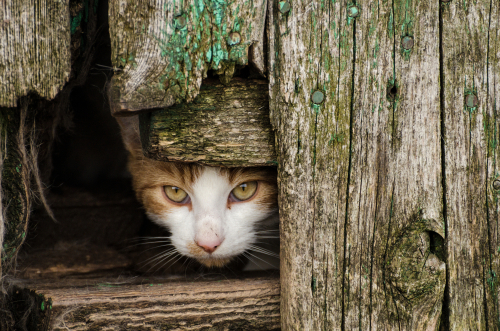
Here in Minnesota, winter weather has officially arrived with all its snow and chilly air. As a cat lover from way back, this had me thinking of our furry feline friends – specifically, the ones who live outside all the time.
Stray v. Feral – What’s the Difference?
Unowned outdoor cats are commonly called “feral”, although a kinder description is community cats. Sometimes simply considered “wild”, feral cats differ from our house cats or even stray cats in that they live without any human contact, nor do they desire any. (Not so hard to believe, if you’ve ever loved a cat!) Usually hidden during the day, these cats are very aloof and independent and live in colonies. Most have never experienced human interaction – and they prefer it that way!
Given that there are 70 million feral cats in the US today, it’s likely you may have seen them before. But how would you even know? An easy way to tell the difference between a stray and a feral cat is by just observing their behavior. Feral cats hide from people. They crouch when approached, wrap their tail around themselves as self-preservation, make no eye contact, and usually have clean, well-kept coats. They are used to being quiet, and it is unlikely they will meow to you.
Strays and lost cats act quite differently. A stray or lost cat may approach you, raise their tail upwards showing friendliness, make eye contact, and their coat may appear unclean or disheveled. Strays tend to be more vocal (they may be used to meowing for dinner or attention!). Strays are easier to catch and find homes for; community cats, on the other hand, are not easy to trap.
Aren’t Feral Cats “bad”?
It’s true that feral cats may have their downsides. Like most “wild” animals, they are known to carry diseases – and common cat diseases such as toxoplasmosis and cat scratch fever can affect humans. Feral cats are often considered a menace to the bird population where they live. And, finally, feral cats get a bad rap for being a nighttime nuisance. They are often awake when you’re trying to sleep, and they can be noisy when mating or fighting with each other.
But even with all the “negatives” some see to feral cat colonies, these community cat colonies have benefits, too. Feral cats often thrive when given something to do, which makes them excellent for keeping the rodent population to a minimum. This may make them ideal animals to work alongside if you happen to be near a barn, factory, outbuildings, or warehouses. Similarly, they may be keeping the rodent population to a minimum near your apartment complex – another spot cat colonies may take up residence near. Just a little support can keep your local community not just surviving but healthy, greatly reducing the risk to humans while bringing about their rodent-reducing benefits.
Living Alongside Feral Cats
Outdoor cats have coexisted with humans for thousands of years and should be protected along with the other wildlife we love. Thankfully, it can be relatively simple to have healthy, safe colonies with just a little compassion and community effort. Because let’s face it – while we may not relish some of their behaviors, feral cats love their life! But, I get it – maybe you want to redirect your local cat colony or keep them out of your concerned neighbor’s yard.
For those interested in helping their local community cat colony safely and humanely, first consider reducing their numbers overall with a TNR (trap, neuter, release) program. This can be an ongoing effort, it’s true, but over time does bring down the numbers in a population. Often, the same cats who are trapped in this program are also vaccinated (though not always), reducing the opportunity for disease. Here in Minnesota, we have the SNAP program for reduced or no cost neutering – http://www.mnsnap.org; a quick on-line search will assist you in finding a program close to you. Many exist, and most will offer advice and guidance on getting through the process.
It’s beneficial to think like a cat if you’re looking to protect them. Don’t think that way? For those of us that don’t, there are plenty of other good resources that exist to help you support these fine felines.
More Resources
Do you know of a feral cat colony close to you? Here are some places you can turn to if you would like some assistance in managing your local cat community. These groups can help with trapping, vaccinations and give you ideas on how to live with this fine group of felines. Alley Cat Allies has a whole host of information on maintaining outdoor cats. Forgotten Cats is a no-kill organization with a focus on trapping and neutering every cat within a colony to help reduce numbers; they are regional to the East Coast areas but can also connect you with resources (and advice) closer to you. The Humane Society and ASPCA similarly have programs of their own or can connect you to other supportive groups in your neighborhood.

Recent Comments